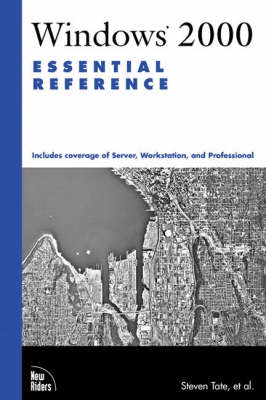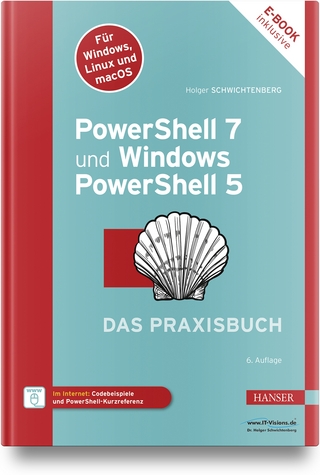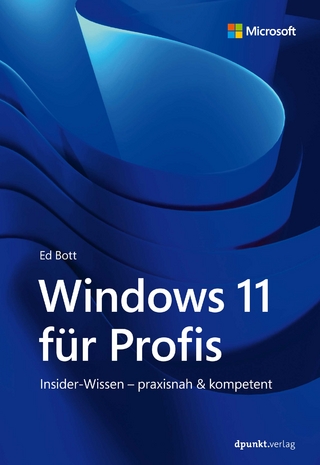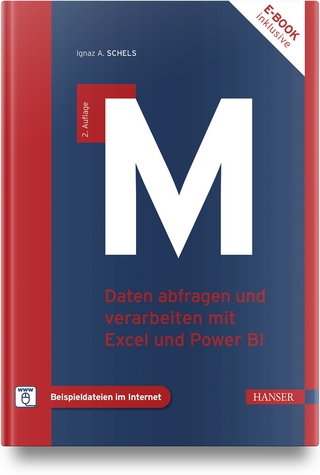
Windows 2000 Essential Reference
Sams Publishing (Verlag)
978-0-7357-0869-3 (ISBN)
- Titel ist leider vergriffen;
keine Neuauflage - Artikel merken
Like other Essential Reference books, this will be a unique, focused, easy-to-use reference for anyone who administers, supports or manages a Windows 2000 network. It will provide a concise, technically accurate distillation of the essential information an administrator would need to know to successfully administer Windows 2000 in a real-life, enterprise production environment. Most administrators will find it hard to get their hands around the Active Directory, Kerberos authentication, IntelliMirror, group policies, and other new technologies in Windows 2000 because of their complexity. These administrators will be searching for a reliable and expert source of advice that will help them successfully implement these new technologies.
Steve Tate, MCT and MCSE, has had seven years of experience with Windows NT and NetWare LAN administration. Most recently, Steve has focused exclusively on training and consulting on networking with Microsoft technologies. He was selected by Microsoft to be a member of the Windows NT 5.0 Rapid Deployment Team and has also developed exam items for Microsoft for use in Microsoft Certified Professional exams. His authoring experience includes two New Riders Publishing books: MCSE Training Guide: Windows NT 4 Workstation and Windows NT Server 4: Security, Troubleshooting, and Optimization. Prior to teaching MS-certified courses, Steve was a trainer/consultant specializing in end-user applications training. He also dabbled in corporate life (a Systems Analyst programming in COBOL), and had stints as a PC analyst, computer salesman, and graduate student. Jon Boggs is an MCSE, MCSD, and CNE. As a senior consultant for the eBusiness Networks practice of Xpedior Incorporated in Chicago, he has provided consulting services to a number of nationally known corporations. He is an expert at automating administrative tasks and system deployments, typically employing a mix of Windows NT/2000, SMS, and Visual Basic. Jon co-authored Planning for Windows 2000 and served as a technical reviewer on several BackOffice-related books. He enjoys reading and biking in his spare time. Scott Burgess is a Managing Consultant and Sr. eBusiness Architect for Xpedior Incorporated, the number one Microsoft solution provider of the year worldwide for both 1997 and 1999. Scott is an MCSE+I and is MCT certified to teach all the current Microsoft products, including the new Windows 2000 curriculum. Scott has 15 years of experience implementing and designing enterprise-wide LAN, WAN, and heterogeneous operating system environments, including OS390, AS400, UNIX, NT, and OS/2. In the past two years, Scott's focus has been centered on the in-depth beta testing of Windows 2000. Through his involvement with Microsoft's JDP program (Joint Deployment Program), Scott and his team have architected and implemented several rollouts of Windows 2000 to international customers. Randy Cook is an independent contractor from Salt Lake City, Utah. His qualifications include Certified Novell Instructor, Master CNE, Microsoft Certified Trainer, MCSE, and the Cisco CCNA. He is currently working for Blue Cross/Blue Shield of Florida as a LAN Architect in their NT Enterprise and teaches in his spare time at Productivity Point International, Jacksonville Florida. He has an extensive background in distributive network integration and Directory Services. Jeremy Deats (jeremy@pdq.net) is a Web application developer and e-commerce consultant with Penta, Inc. in Houston, Texas. Jeremy is a Microsoft Certified Professional in Visual Basic and is certified in IBM's Net.Commerce. When he's not hard at work, Jeremy is either spending time with his beautiful fiancée Amanda Clement or playing his guitar. Art Henning's 14-year career with Intergraph Corporation includes a wide scope of experience in a support role for hardware, software, and networks with VAX VMS, various flavors of Unix, and WinNT, beginning with beta versions of 3.1. Art was staffed for three years as a Software Analyst and Consultant for Intergraph's NFS products, which were licensed to Microsoft and released as part of the WindowsNT Services for Unix bundle. This included certification work with Windows 2000. He currently is a Systems Administrator for one of Intergraph's MIS departments, and is an MCP. Chris Jones is a Microsoft Certified System Engineer. He holds a B.S.B.A. in Management Information Systems and Finance from the University of Arizona. Chris is currently a Senior Systems Programmer for Intel Corporation. His experience at Intel has included engineering and implementation of enterprise Windows NT infrastructure architectures and extensive involvement in Microsoft's Joint Development Program for Windows 2000. Chris enjoys mountain biking, golf, and Tae Kwon Do in his spare time. Thomas Lee is an independent computer consultant who has been working with Windows NT since 1993. After graduating with a BS in Computer Problem Solving from Carnegie Mellon University, he worked on two successful operating system projects (Comshare___s Commander II and ICL___s VME) before joining Andersen Consulting in 1981, where he was a manager in the London office. He has been an independent consultant since 1987. Most recently, he worked in Redmond developing Windows 2000 Microsoft Official Curriculum (MOC) training material and is presently engaged in several consulting projects relating to Windows 2000. Thomas is a Fellow of the British Computer Society and a Member of the Institute of IT Trainers, as well as being a Microsoft Certified Systems Engineer (MCSE), Microsoft Certified Trainer (MCT), and Microsoft Valued Professional (MVP). Thomas lives in a cottage in the English countryside with his wife, Susan, and daughter, Rebecca. You can contact Thomas at tfl@psp.co.uk. Mary McLaughlin, MCSE+I, MCT, ASE, ACT, lives in the Boston area with her beloved daughter, Margaret. She started as a systems administrator 10 years ago, and has worked consistently on small- to medium-sized LANs and WANs for profit and non-profit organizations. In the last five years, her focus has been on training individuals in Windows 2000, Windows NT, and Compaq technologies. Currently, she is involved in security solutions such as firewall, VPN, and PKI technologies. Jim Mulvey is a Microsoft Certified Systems Engineer (MCSE) and Microsoft Certified Trainer (MCT). He has a BS in Electrical Engineering from the University of Connecticut. His 13 years of experience in the IT industry include project management, architecture, systems engineering, and technical support under a variety of platforms. He is currently a Senior Consultant with Xpedior Incorporated, an eBusiness solutions provider awarded Microsoft's "Partner of the Year¿Worldwide" award for 1997. His experience at Xpedior includes engagement in Microsoft's Joint Deployment Program for Windows 2000, in which he was project manager and chief architect for one of the first production Windows 2000 Domain designs. James O'Neill was born in 1965 and lives near Oxford, England. After doing a BSc in Computer Science at the University of Exeter, he joined the UK's biggest supplier of PCs for schools, where he planned and supported customers' networks before leaving in 1993 to work in the IT training industry. In 1995 he became Managing Director and major shareholder of SHX, a Microsoft Certified Technical Education Centre, before selling it in 1998, but continued to teach Windows NT and Microsoft Exchange. In 1999, he worked as part of Microsoft's team developing the MCP exams for Windows 2000. He married his wife Jackie in 1989 and their daughter Lisa was born in January 2000. He collects quotations and has the irritating habit of talking about himself in the third person. David Shackelford holds a master's degree from California State University at Fullerton. His background includes working as a beekeeper, screening submissions for a popular poetry journal, and teaching NT operating system and networking courses at Hewlett Packard and Intel. He currently works for a firm in southern California as the supervisor of network operations. Paul Papanek Stork is a Senior Lecturer and Director of the E-Ideas Lab for Weatherhead School of Management at Case Western Reserve University. Paul has an MBA from Weatherhead and is a Microsoft Certified Trainer, a Microsoft Certified Systems Engineer plus Internet, and a Certified Novell Engineer with more than 14 years of experience designing, implementing and supporting Microsoft and Novell Networks. Prior to his appointment as a lecturer at Weatherhead in January of 2000, Paul was an active member of Microsoft's Windows 2000 Rapid Deployment Program for DeCarlo, Paternite, and Associates, Inc. As a staff instructor at DPAI, he was one of the first MCTs in the Midwest to teach beta classes on Windows 2000 to other trainers and network engineers.
I. THE WINDOWS 2000 ENVIRONMENT.
1. Overview of Windows 2000 Architecture. Version of Windows 2000. Windows 2000 System Architecture. Windows 2000 Security.
2. Introduction to Active Directory.
Active Directory and Windows 2000. Organization of Active Directory. Going Deeper: Domain Controllers and Active Directory.
II. INSTALLING AND CONFIGURING WINDOWS 2000 SERVER.
1. Overview of Installing and Configuring Windows 2000 Server.
Installing Windows 2000 Server. Configuring Devices and System Settings. Configuring Network Components. The Boot Process. The Registry.
2. Installing Windows 2000 Server.
Using Windows 2000 Setup. Upgrading to Windows 2000 Server. Automating Setup. Creating and Using Installation Scripts. Remote Installation Services. Using System Images.
3. Configuring Devices and System Settings.
Overview. Installing and Configuring Device Drivers. Configuring System Settings. Going Deeper: Windows 2000 Demand Paging. Best Practices.
4. Configuring Network Components.
Network Components Overview. Configuring Network Interfaces. Configuring Network Protocols. Configuring Network Services. Configuring Network Bindings. Troubleshooting Network Connectivity.
5. The Boot Process.
The Normal Boot Process. Understanding boot.ini. Using Advanced Boot Options. Creating a Windows 2000 Boot Disk. Troubleshooting the Boot Process.
6. The Registry.
Introduction to the Registry. Registry Security. Registry Physical Storage. Using the Registry Editor. Troubleshooting Registry-Related Tasks.
III. TOOLS FOR ADMINISTRATION.
1. Getting Started as a Windows 2000 Administrator.
A Day in the Life of a Windows 2000 Administrator. Knowing Your Tools. Planning Ahead: Creating the Environment for Success. Tips and Tricks to Automate Administrative Tasks. Avoiding Crisis: Monitoring Your Network. Windows 2000 Administration Best Practices.
2. Using MMC Consoles.
Overview of the Microsoft Management Console. Using and Creating Consoles. Distributing Custom Consoles to Users.
3. Using Administrative Tools.
Overview of Administrative Tools. Active Directory Administration Tools. Other Administrative Tools. Troubleshooting and Diagnostic Tools.
4. Managing Services and Tasks.
Managing Services. Managing Tasks. Scheduling Tasks.
IV. MANAGING THE DIRECTORY.
1. Overview of Managing the Directory.
DNS and Active Directory. Configuring a Domain Controller. Creating and Managing User Accounts. Creating and Managing Groups.
2. DNS and Active Directory.
The DNS Namespace. The DNS Resource Records. Storing DNS Information in the Active Directory. Maintaining Zones in Windows 200 DNS. Using Third-Party DNS Servers with the Active Directory.
3. Configuring a Domain Controller.
Installing Active Directory. Configuring Active Directory Replications. Modifying the Active Directory Schema. Going Deeper: Restructuring Domains.
4. Creating and Managing User Accounts.
Overview of User Accounts. Local (SAM) Accounts. Domain User Accounts. Administering User Accounts. Best Practices When Administering Accounts.
5. Creating and Managing Groups.
Overview of Groups. Local (SAM) Groups. Domain Groups. Nesting Groups. Default Domain Groups. Creating, Deleting, and Modifying Group Accounts. Best Practices for Managing Group Membership.
6. Logging On and Authentication.
Logging One. Configuring Systems to Log On to a Domain. Going Deeper: How a Windows 2000 System Authenticates a User. Troubleshooting.
V. MANAGING FILES AND PRINTERS.
1. Overview of Managing Files and Printers.
File Systems and Disks. Sharing Folders. Distributed File System. Sharing Printers. Protecting Data. Auditing Resource Access.
2. File Systems and Disks.
File Systems. File System Format. NTFS Permissions. File and Disk Utilities. Disk Quotas. Disk Configurations. Best Practices.
3. Sharing Folders.
Overview of Shared Folders. Creating a Shared Folder. Setting Permissions On Shared Folders. Monitoring and Testing Shared Folders. Connecting to Shared Folders. Publishing Folders in the Directory.
4. Distributed File System (DFS)
DFS Overview. Setting Up a DFS Root. DFS Client.
5. Sharing Printers.
Sharing Print Resources. Publishing Printers in the Directory.
6. Auditing Resource Access.
Overview of Auditing. Auditing Access to Files. Auditing Access to Printers.
7. Protecting Data.
Overview of Data Protection. Virus Protection. Fault-Tolerance. EFS and EFS Recovery. Backup and Restore. Disaster Recovery.
8. Internet Information Server.
Introduction to Internet Information Server. Installing and Configuring Internet Information Server. Administering WWW Services. Administering FTP Services. Creating and Managing Virtual Directories and Servers. Creating and Managing Virtual Directories and Servers. Using Indexing Services. Administering IIS Security.
VI. MANAGING USER DESKTOPS.
1. Overview of Managing User Desktops.
Overview of User Desktop Management. Customizing the Environment.
2. Profiles.
Profiles. Local Profiles. Roaming User Profiles. Mandatory User Profiles. My Document Folders. Offline Folders.est Practices.
3. Group Policies.
Introduction to Group Policies. Delegating Administration of Group Policies. Using Group Policies to Manage User Documents and Offline Folders. Best Practices for Group Policy Architecture and Application.
VII. MANAGING APPLICATIONS.
1. Overview of Managing Applications.
Windows 2000 Software Distribution and Management. Publishing and Advertising Applications. Windows Installer. Upgrading, Patching, and Removing Applications.
2. Publishing and Assigning Applications.
Publishing Applications. Assigning Applications. Applying Transforms. Upgrading Applications. Setting Software Installation Defaults. Removing Applications. Creating Software Policy Templates. Controlling Software Deployment through Group Policy Object Settings. Going Deeper: Practical Applications. Best Practices.
3. Windows Installer.
Window Installer. Components, Features, and Products. Windows Installer File Types. áNative” Windows Installer Packages. Repackaging and Application. Create .zap Installation Files. Customizing Packages. Modifying Windows Installer Behavior.
VIII. MANAGING NETWORK SERVICES.
1. Overview of Managing Network Services.
Physical Network Planning. IP Addressing. Name Resolution and Service Registration. Managing Client Network Configuration. Managing Server Network Configuration. Managing Server Network Performance.
2. Dynamic Host Configuration Protocol (DHCP).
Overview of DHCP. IP Address Lease Process. Installing and Configuring DHCP Server. DHCP Scopes. Dynamic DNS Integration. Working with RRAS. Enabling Server-side Conflict-Detection. Enabling Logging. Maintaining the DHCP Database. DHCP Clients. Frequently Asked Troubleshooting Questions.
3. Domain Name System (DNS).
Overview of DNS. DNS and Name Resolution. DNS Zones. Installing DNS. Creating Zones. Resource Records. Dynamic DNS. Configuring DNS Servers. Testing Tools. Best Practices.
4. Windows Internet Name Service (WINS).
Overview of WINS. Installing WINS. Configuring WINS Servers. Maintaining the winds Database. Backing Up and Restoring the WINS Database. Configuring WINS Replication. WINS Clients. Monitoring WINS. NetBIOS Names Reference.
5. Remote Access Service (RAS).
Overview of Windows 2000 Remote Access Server. Installing RAS Servers. Configuring RAS User and Clients. Internet Authentication Service. Troubleshooting Dial-up Connections. Testing and Monitoring RAS. Overview of VPNs.
6. IP Routing.
IP Routing Overview. Demand-Dial Routing. Routing Protocols. Multicasting. Testing and Monitoring IP Routing. Scripting Router Configuration. Going Deeper: Practical Applications.
7. Connection Sharing.
Overview of Connection Sharing. How Network Address Translation (NAT) Works. Configuring Connection Sharing. How Network Address Translation (NAT) Works. Configuring Connection Sharing. Choosing IP Addresses for the Internal and External Networks. Configuring Inbound Connections. Configuring Applications and Services. Testing and Monitoring Connection Sharing. Best Practices.
8. Terminal Services.
IX. APPENDICES.
Appendix A: Migrating NT 4 Domains to Active Directory.
Designing Your Active Directory. Restructuring NT Domains. Windows 2000 Migration.
Appendix B: Command Prompt Quick Reference.
Networking Utilities. IP Networking Utilities. Utilities. Batch Commands. Environment Commands.
Appendix C: Sample Batch Files.
RAND BAT. VIRUPDATE.BAT.
Appendix D: Resource Kit Utilities.
Disk and File Utilities. Migration Utilities. Network Utilities. PC Management Utilities. Performance Utilities. Troubleshooting Utilities.
Index.
| Erscheint lt. Verlag | 26.4.2000 |
|---|---|
| Verlagsort | Indianapolis |
| Sprache | englisch |
| Maße | 149 x 228 mm |
| Gewicht | 889 g |
| Themenwelt | Informatik ► Betriebssysteme / Server ► Windows |
| Mathematik / Informatik ► Informatik ► Netzwerke | |
| Informatik ► Weitere Themen ► Hardware | |
| ISBN-10 | 0-7357-0869-X / 073570869X |
| ISBN-13 | 978-0-7357-0869-3 / 9780735708693 |
| Zustand | Neuware |
| Informationen gemäß Produktsicherheitsverordnung (GPSR) | |
| Haben Sie eine Frage zum Produkt? |
aus dem Bereich


